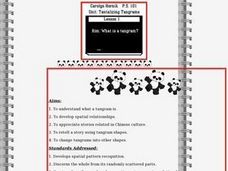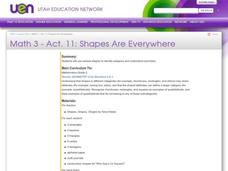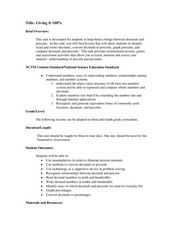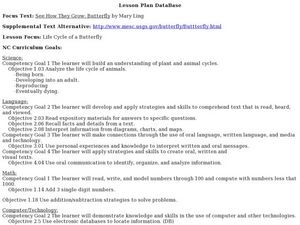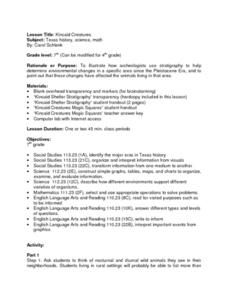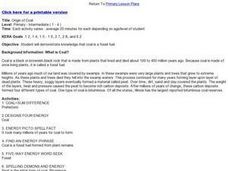Curated OER
Mandalas : polygons
Fourth graders create mandalas. In this mandala lesson, 4th graders look at these polygons in nature and man-made forms. They create their own by using tangrams.
Curated OER
What is a Tangram?
Students identify a tangram. In this geometry lesson, students read Grandfather Tang's Story and retell each story using the tangrams on a flannel board. Students use tangrams to complete an included worksheet.
Curated OER
Shapes Are Everywhere
Third graders use various shapes to identify polygons and understand symmetry. They explore pattern blocks noticing their similarities and differences, then share with other team members. They draw 3 polygons in their journals and...
Curated OER
Giving it 100%
Learners build knowledge about the number relationships between decimals and percents as it relates to converting decimals into percents. In this decimal and percent lesson, students recognize equivalent forms of fractions,...
Curated OER
A Scheduling Dilemma
Students solve train-scheduling word problems using a four-step problem solving model. In this problem solving lesson, students work in groups to a four-step procedure about a train scheduling dilemma.
Curated OER
Ship Shape
Second graders explore shapes. After reading books about shapes, 2nd graders describe the properties of various shapes. They identify shapes if they have been rotated, flipped, or slid. Students create shapes using drawings and geoboards.
Curated OER
Building Patterns Incrementally
Students study the recurrence rules for patterns where the increase from one term to the next is not constant. They look for the recurrence rule on their own. They copy the pattern and create the next element, continue the pattern with...
Curated OER
Space Tiling with Captain Planet
Fifth graders Apply the symmetry and angle properties of polygons, using symmetry and angle properties of polygons to solve practical problems. They study tessellates and explain why a shape tessellates.
Curated OER
2-D Geometry
Third graders describe and compare attributes of two-dimensional shapes. They explain geometric terms, angles and shapes. Students demonstrate each vocabulary word with their body and they mirror the body positions associated with each...
Curated OER
Triangulation
Students calculate the triangulation of a box. In this triangulation lesson plan, students participate in an activity to find the calculate and then perform triangulations. They create a box and use formulas to determine the...
Curated OER
Mathematics of Fair Games
Students study about mathematicians' notion of fairness in games of chance. They work in pairs to perform three different experiments using macaroni and paper bags. They record their results on charts and discuss the fairness of the games.
Curated OER
See how They Grow: Butterfly
Students view butterflies and participate in a butterfly activity to learn needed vocabulary. In this butterfly life cycle lesson, students access prior knowledge of butterflies. Students listen to a butterfly life cycle book....
Curated OER
Kincaid Creatures
Learners brainstorm a list of nocturnal and diurnal wild animals they see in their community and discuss how the animals would be different if they were living during the Ice Age. Using a handout, they discover how archeologists record...
Curated OER
What is Coal?
Students receive instruction to answer the question "What is coal?". They then participate in several puzzles and problems to explore the subject of coal. They solve addition and subtraction problems and match letters with the letter...
Curated OER
What Is It? Tommy Tastes
Students complete multi-curricular to learn about senses and sensory words. For this sensory words lesson, students discuss the five senses and the anatomy of a tongue. Students complete a food tasting activity and find descriptive words...
Curated OER
What is it? Sally Smells!
Students explore the attributes of the human nose. For this 5 senses lesson, students participate in a smell guessing game prior to discussing the anatomy of the nose and creating a sense of smell book page.
Alabama Learning Exchange
Alex: Imaginary Numbers? What Do You Mean Imaginary?
Is it any wonder that young scholars are suspicious? We lead, sometimes drag, them through Algebra I insisting they must follow the order of operations. We make them learn the "hard way" of doing an assignment one day only to show them...



